This was published 7 years ago
Mekong river cruise, Cambodia: Anchored in Angkor
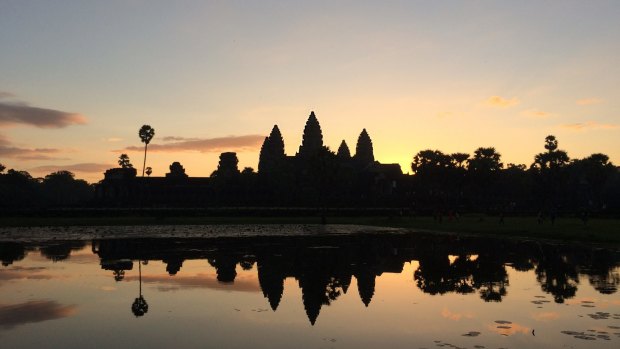
Watch dawn break over the towers of Angkor Wat.
There is a time in every traveller's life when they will be asked to perform for a foreign culture. Be asked to sing their national song, tell a traditional story, dance the dance of their country. Here, on the banks of the clay-coloured Mekong river in Cambodia, I have just been asked to do the latter.
Before me is a sea of expectant upturned faces, a tumble of local children. We've been having a bit of a twilight disco, and these kids have been showing me and my travel companions their graceful traditional Khmer dancing, all tai chi-like movements and delicate flex-fingered hand gestures. Now, it's our turn.
I take a panicked look over at a fellow traveller. We both know our options are slim.
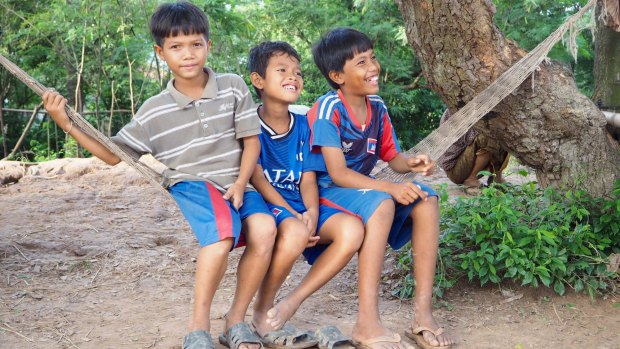
The locals are all smiles.Credit: Nina Karnikowski
"Know any Aboriginal dances?" I ask her, knowing the answer already but clutching at straws.
"Err … What about the Nutbush?", she asks.
"Is that even Australian?"
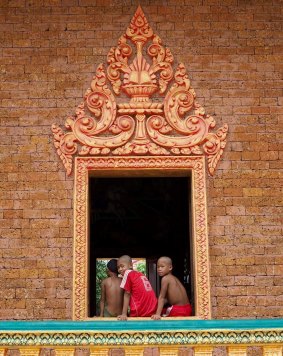
Temples abound along the Mekong.Credit: Nina Karnikowski
"I'm not sure, but …" she trails off, gesturing at the hopeful faces. We look at them. We look back at each other. We know we have no choice.
Resting our hands on our waists we tap our feet side to side, back and forth, side to side again, then jump 90 degrees to the left. We get lost, start throwing invisible lassoes in the air, try a few high kicks, and for some reason throw a '60s The Swim move in there. We lack precision, but damn it, are we enthusiastic.
Our audience, bless them, are trying their best to mirror our haphazard show. Their parents, content sitting on the sidelines watching the spectacle unfold, are laughing so hard some of them are slapping their thighs.
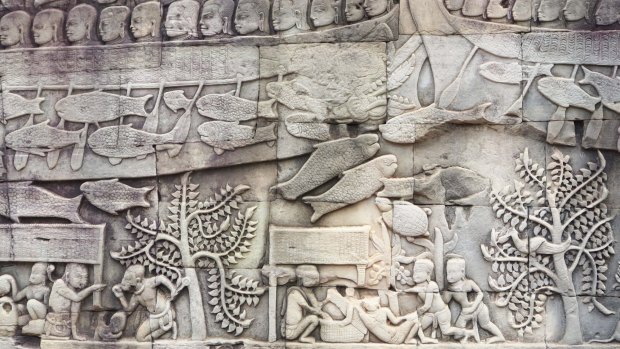
Finely-crafted frescoes.Credit: Nina Karnikowski
While our dancing may not have won us any prizes, the night is one we know will stay with us long after we arrive back home. We know how lucky we are to be on this sleepy slice of riverbank in Angkor Ban village which, without travelling on our small 24-cabin Mekong Pandaw ship, we may have missed entirely. But then that's the thing about cruising; it can get you to out-of-the-way places. It's like the road trip of the waterways. A posh road trip, with cocktails and a la carte menus, but a road trip nonetheless.
After our dancing, and indeed after every excursion off the ship, our shoes are whisked away for cleaning. A signal that it's time to retire to the breezy top deck. Shaded by awnings and extending the 60-metre length of the ship, there's a pool table in the middle and a bar at the far end. Daily cocktail, or gelato? This is our toughest daily decision.
Our adventure along the Mekong began two days ago in Siem Reap, the gateway to Angkor, hundreds of Khmer temples dating from the ninth to 15th centuries. We watched dawn break over the corn-cob towers of Angkor Wat, the most impressive of them all, surrounded by a constellation of glowing camera screens as our guide whispered tales of the ancient Khmer empire. We explored Siem Reap's central market and hip Kandal Village, and sipped cocktails at the iconic Foreign Correspondents' Club. Before long the Mekong Pandaw whisked us away, slipping past tall, slender sugar palms to the French colonial village of Chhlong with its romantically dilapidated mansions, and to the World Wildlife Fund-protected Irrawaddy freshwater dolphin sanctuary. Travelling further downstream we arrived here in Angkor Ban, exploring dusty laneways peppered with towering haystacks, big white humpbacked Brahmin cattle, and century-old stilted houses that survived three decades of civil war.
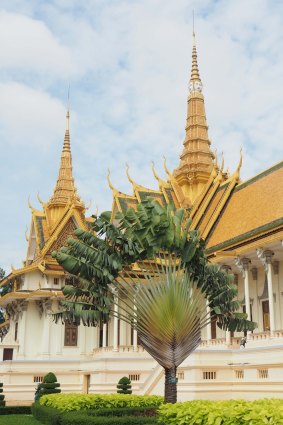
Classic Indo-chinese architecture.Credit: Nina Karnikowski
At the end of each of these adventures we retreat back to the luxury of our ship, one of Pandaw Expeditions' fleet of timber vessels built to look like colonial river steamers, replicas of the heritage ships of the Irrawaddy Flotilla Company. Lacquered louvered doors lead to the teak-panelled cabins, each with its own comparatively spacious marble-benched en suite, while waving palms and wicker chairs dot the timber decks.
The vintage aesthetics, however, belie both the ships age (15 years) and its arsenal of mod-cons that would surely satisfy even the most comfort-conscious traveller. There's Wi-Fi, air-con, a spa, a gym and even a cinema, where nightly films tied to the locations we pass are screened (Pandaw keep things classy with no in-room teles). And then there's the food. Oh, the food! Cambodian fish amok with lemongrass, turmeric and galangal is a highlight, as are the noodle stations with create-your-own coriander and ginger-infused Vietnamese pho. Even the decadent salad bar impresses our terry towelling slippers off.
By day four we've reached Phnom Penh, and after breakfast we find two dozen rickety green cyclos lined up on the shore, ready to take us on a morning tour. We weave through the chaotic streets, passing tangerine-robed monks on the back of motorbikes, street carts heaving with fresh green drinking coconuts, and tiny street stalls selling crispy shrimp crackers. On the way we stop off to explore the Royal Palace with its delicate Khmer roof and elaborate gilding, and the National Museum where we discover the world's finest collection of Khmer sculpture and a lovely courtyard garden.
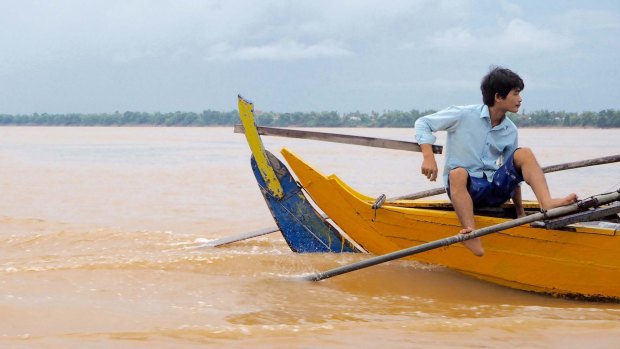
Navigating the Meekong.Credit: Nina Karnikowski
Cambodia's history is one drenched in pain and hardship, and in the afternoon we get a heart-wrenching insight into it. We travel by coach outside the city to Choeung Ek, one of around 400 killing fields where some 17,000 people died during Pol Pot's brutal regime (over a million were killed by the regime in total). The field appears innocuous enough at first glance, like a lush park dappled by trees, but the sorrow that lies in the tear-soaked soils soon reveals itself: In the friendship bands travellers leave hanging from posts to honour the dead. In the signs asking visitors not to remove bones, which are still today getting exposed by heavy rains. And in the central glass-walled tower which houses 8000 human skulls, their genders, ages and causes of death denoted by round coloured stickers. A harrowing experience that, along with a visit to the genocide museum on the site of the Khmer Rouge's S21 detention centre, leaves us all in sombre silence on the drive back to our ship.
The following morning, the river is suddenly busier. We've glided over a liquid border and are now in Vietnam, where three-quarters of the country's cargo is transported by water, and where 95 per cent of food comes from the Mekong region. Scattered atop the passing vessels and along the riverbanks are locals crouched in concentration beneath their coolie hats, busy as pyjama-clad bees.
We slide further down the mighty Mekong, and an increasing amount of farmland and rice paddies stretches away from the muddy banks. When we stop in local villages we immediately sense the presence of greater resources here than in Cambodia. As one of my fellow travellers, a regular Vietnam visitor, astutely puts it at one point, "You would never show a kid their face in a mobile phone here like you would in Cambodia, because they've probably got one themselves."
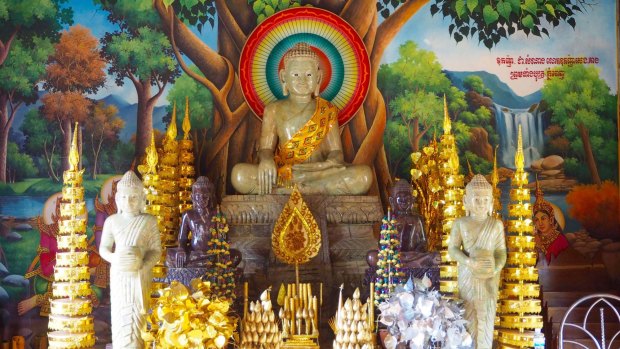
Buddhist offerings.Credit: Nina Karnikowski
Our Vietnamese itinerary includes a fish farm, a sweet factory, a floating fruit market and a Muslim weaving village. Excursions are all taken on local wooden sampan boats, and highlight the scope of the riverside industry and Vietnam's "agriculture culture", as our guide dubs it. Cambodia's temples, palaces and monks have been replaced by fishing trawlers, boats hauling mounds of rice and sand, and little sampan supermarkets. Many of their prows are painted with big round eyes, which our guide says help the boats find their way back to dry land.
Sadly, soon it's our turn to find our way back to dry land too, and to bid farewell to our floating home and the magic of the Mekong.
Nina Karnikowski travelled courtesy of Wendy Wu Tours and Malaysian Airlines.
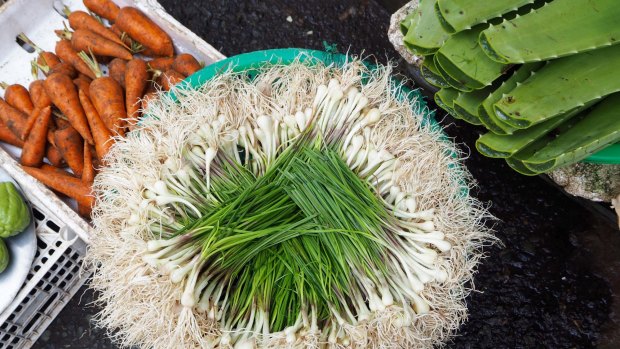
MarketCredit: Nina Karnikowski
TRIP NOTES
MORE
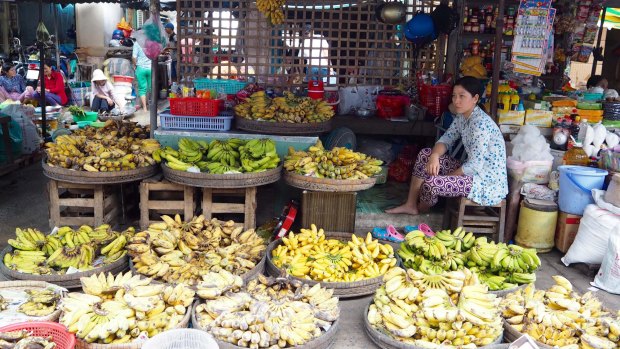
Markets offer fresh local produce.Credit: Nina Karnikowski
FLY
Malaysia Airlines flies to Siem Reap via Kuala Lumpur from every capital city for about $1100 return. See malaysiaairlines.com
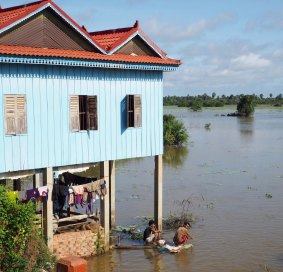
Stilt houses lined sections of the Meekong.Credit: Nina Karnikowski
TOUR
Wendy Wu Tours offers a range of Pandaw River Cruise itineraries, and a selection of private pre and post cruise itineraries for independent travellers. The Classic Mekong cruise itinerary aboard the RV Mekong Pandaw travels from Siem Reap to Saigon (and the reverse) over eight days, from $3755 per person twin share. See wendywutours.com.au
FIVE MORE UNFORGETTABLE MEKONG EXPERIENCES
1. WAT PREAH ANGKOAK CAVE TEMPLE, CAMBODIA
At the end of a jungle path leading from your mooring, and up a long terracotta-coloured stairway, you will find this small Buddhist temple set inside a cave. Two monks guard the entrance and will help you figure out how to correctly give an offering, while monkeys play in the trees outside. Pure magic.
2. KAMPONG TRALACH VILLAGE OX CART RIDE, CAMBODIA
Take a "Khmer limousine", aka a wooden ox cart, through the traditional Cambodian village of Kampong Tralach. The ride takes about 20 minutes passing traditional stilted houses and rice paddies, and ends at the local vihara (Buddhist monastery), home to giggling young monks.
3. PREK KDAM SILVERSMITH VILLAGE, CAMBODIA
Prek Kdam has been producing silver decorative arts and supplying the Royal Palace in Phnom Penh since the sixth century, and most of the 250 families in the village are involved in silver work. Here, you can visit the main workshop to see how the silver-plating is done, and visit the adjoining shop to buy genuine silver jewellery, cutlery, ornaments and more.
4. SA DEC LOVER MANSION, VIETNAM
The magnificent old house of Mr Huyn Thuy Le is famous in this village, since steamy scenes from the film version of Marguerite Duras' celebrated novel The Lover were shot here. But it's really Sa Dec's produce market – where you'll find everything from vibrantly coloured tropical fruit and veg and seafood, to pigs' legs and live frogs, ducks and chickens – that steals the show.
5. CHAU DOC CHAM VILLAGE, VIETNAM
Take a sampan ride to Chau Doc, where people of the mostly Muslim Cham ethnic minority live, to witness their traditional weaving practices and to visit the lovely local mosque.
Sign up for the Traveller Deals newsletter
Get exclusive travel deals delivered straight to your inbox. Sign up now.